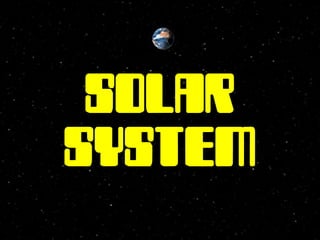
Solar system
- 1. Solar system
- 2. The Solar System consists of the Sun, eight planets, and other smaller constituents
- 3. The Inner Planets and Outer Planets tell many tales about the wonders of the Solar System While the gems in space unveils the myth of our galaxy far beyond imagination..
- 4. Welcome to The SOLAR SYSTEM
- 5. Solar system Inner planets Outer planets Click on objects to find out more about them!
- 6. •All the nine planets move around the Sun in a large oval path. •The planets also spin by itself. •The Sun is the only star in the solar system. •A star is an object in space that gives out light and heat. •The Sun is also the biggest object in the Solar System. SUN s The Sun is in the centre of the Solar System. All the eight planets move around the Sun in a large oval path. The Sun is the only star in the solar system. A star is an object in space that gives out light and heat. The Sun is also the biggest object in the Solar System.
- 7. mercury Mercury is the nearest planet to the Sun. It is 58 million km from the Sun. Its surface that faces the Sun has a very high temperature of 430°c. The temperature is too hot to support life. This high temperature causes no liquid water to exist on this planet. Mercury rotates very slowly.
- 8. venus Venus is the second nearest planet to the Sun. It is the hotter than Mercury because a great amount of the heat from the Sun is trapped in its atmosphere. It is the brightest object in the sky besides our Sun and the Moon. Nearly the whole atmosphere consists of carbon dioxide. Venus is often called Earth’s twin because the two planets are close in size, but the conditions on the surface of Venus are completely different.
- 9. EARTH Planet Earth is the third planet from the Sun and the fifth largest planet in the Solar System. The Earth’s atmosphere, weather and many other factors are just right to keep us alive. Earth is a complex system of air, water and land. Earth has one moon, its name is Luna. The Earth’s interior is composed of four layers, three solid and one liquid.
- 10. MARS It is also called the Red Planet or Red World because it is reddish in colour. Mars is the only planet whose surface can be seen in detail from the Earth. Mars is the fourth planet from the Sun. It has a very cold surface so almost all of its water is frozen. Mars is not conducive for living things.
- 11. JUPITER Jupiter is the fifth planet from the Sun . It is the biggest planet in the solar system. It has a diameter of 3000 km. Jupiter is usually the fourth brightest object in the sky (after the Sun, the Moon and Venus); however at times Mars appears brighter than Jupiter. Jupiter has at least 63 moons.
- 12. SATURN Saturn is the sixth planet from the Sun. Saturn is the second largest planet in our Solar System. Saturn has three wide rings. They can be seen with a telescope. Saturn has 34 moons.
- 13. uranus Uranus is the seventh planet from the Sun. Uranus is lying on its side as it goes round the Sun. There are many layers of clouds found in this planet's atmosphere, however these clouds are difficult to see. Uranus has 27 moons.
- 14. Neptune Neptune is the eighth planet from the Sun. Neptune is covered with a blue ocean of liquid methane. Neptune has 13 moons. Neptune appears to have two thin rings, with a third larger ring Back to between them. These rings are previous made up of dark rocky materials. page
- 15. asteroids Asteroids are huge chunks of rocks and metals. Asteroids have different shapes and sizes. Most asteroids have a diameter of more than 200 km. The main asteroids belt occupies the orbit between Mars and Jupiter. Asteroids are left over materials from the formation of the Solar System.
- 16. meteoroids A meteoroid is a piece of rock that is floating in space. There are millions of meteoroids in the solar system. Most of them are small. Every day, a millions of meteoroids enter the Earth’s atmosphere from space.
- 17. meteor Meteors are tiny rocks which probably come from the asteroids belt. When a meteoroid enters the Earth’s atmosphere, it burns very brightly. Friction between the meteoroid and the air causes the meteoroid to burn, is called a meteor.
- 18. comet A comet is made of pieces of ice in space. It is made of water, dust and frozen gases. Comets have long glowing tails.
- 19. SOLAR SYSTEM The Sun and eight other planets are part of the solar system. The eight planets are Mercury, Venus, Earth, Mars, Jupiter, Saturn, Uranus and Neptune. Natural satellites (moons), meteors, comets and asteroids are also the constituents of the solar systems.
- 20. INNER PLANETS Mercury, Venus, Earth and Mars are the four planets that are the nearest to the Sun. They are called the inner planets. All these planets are made of rocks. Each of the inner planet has an atmosphere. The atmosphere of the inner planets is very thin and poisonous to living things, except the Earth.
- 21. OUTER PLANETS The outer planets are Jupiter, Saturn, Uranus, and Neptune. They are mainly composed of gases. Their temperature is too cold to support life.
- 22. BACK
- 23. BACK
- 24. BACK
- 25. BACK
- 26. BACK
- 27. BACK
- 28. BACK
- 29. BACK
- 30. BACK
- 31. BACK